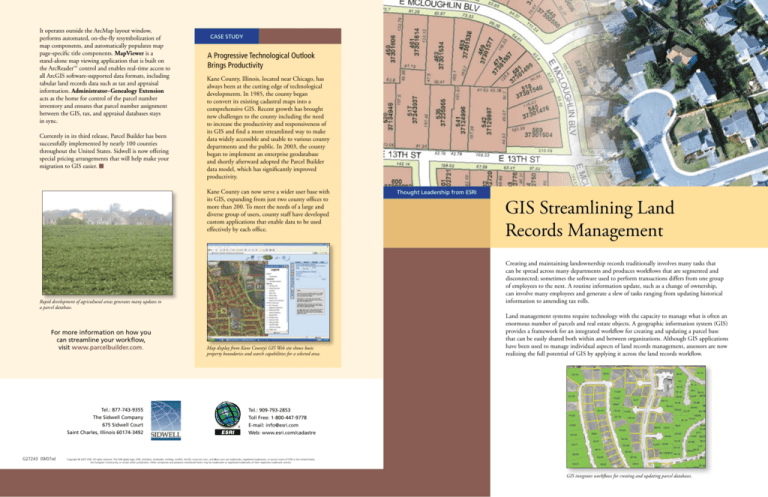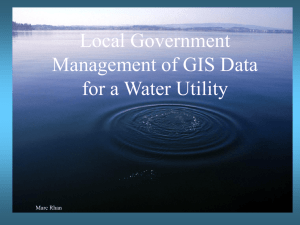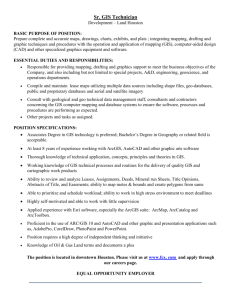
It operates outside the ArcMap layout window,
performs automated, on-the-fly resymbolization of
map components, and automatically populates map
page-specific title components. MapViewer is a
stand-alone map viewing application that is built on
the ArcReader™ control and enables real-time access to
all ArcGIS software-supported data formats, including
tabular land records data such as tax and appraisal
information. Administrator–Genealogy Extension
acts as the home for control of the parcel number
inventory and ensures that parcel number assignment
between the GIS, tax, and appraisal databases stays
in sync.
Currently in its third release, Parcel Builder has been
successfully implemented by nearly 100 counties
throughout the United States. Sidwell is now offering
special pricing arrangements that will help make your
migration to GIS easier.
CASE STUDY
A Progressive Technological Outlook
Brings Productivity
Kane County, Illinois, located near Chicago, has
always been at the cutting edge of technological
developments. In 1985, the county began
to convert its existing cadastral maps into a
comprehensive GIS. Recent growth has brought
new challenges to the county including the need
to increase the productivity and responsiveness of
its GIS and find a more streamlined way to make
data widely accessible and usable to various county
departments and the public. In 2003, the county
began to implement an enterprise geodatabase
and shortly afterward adopted the Parcel Builder
data model, which has significantly improved
productivity.
Kane County can now serve a wider user base with
its GIS, expanding from just two county offices to
more than 200. To meet the needs of a large and
diverse group of users, county staff have developed
custom applications that enable data to be used
effectively by each office.
Tel.: 877-743-9355
The Sidwell Company
675 Sidwell Court
Saint Charles, Illinois 60174-3492
G27243 09/07sd
GIS Streamlining Land
Records Management
Creating and maintaining landownership records traditionally involves many tasks that
can be spread across many departments and produces workflows that are segmented and
disconnected; sometimes the software used to perform transactions differs from one group
of employees to the next. A routine information update, such as a change of ownership,
can involve many employees and generate a slew of tasks ranging from updating historical
information to amending tax rolls.
Rapid development of agricultural areas generates many updates to
a parcel database.
For more information on how you
can streamline your workflow,
visit www.parcelbuilder.com.
Thought Leadership from ESRI
Map display from Kane County’s GIS Web site shows basic
property boundaries and search capabilities for a selected area.
Land management systems require technology with the capacity to manage what is often an
enormous number of parcels and real estate objects. A geographic information system (GIS)
provides a framework for an integrated workflow for creating and updating a parcel base
that can be easily shared both within and between organizations. Although GIS applications
have been used to manage individual aspects of land records management, assessors are now
realizing the full potential of GIS by applying it across the land records workflow.
Tel.: 909-793-2853
Toll Free: 1-800-447-9778
E-mail: info@esri.com
Web: www.esri.com/cadastre
Copyright © 2007 ESRI. All rights reserved. The ESRI globe logo, ESRI, ArcEditor, ArcReader, ArcMap, ArcIMS, ArcGIS, www.esri.com, and @esri.com are trademarks, registered trademarks, or service marks of ESRI in the United States,
the European Community, or certain other jurisdictions. Other companies and products mentioned herein may be trademarks or registered trademarks of their respective trademark owners.
GIS integrates workflows for creating and updating parcel databases.
Local governments generally are concerned with the
issues related to a single, common geography, which
points to the need for a centrally managed and shared
GIS. An enterprise GIS enables users from different
departments in an organization to use common data for
their specific tasks. Adopting an enterprise geodatabase
is more widespread because it helps organizations be
more accountable and efficient. A GIS enables them to
respond to requests for information faster, serve clients
better, and respond to governmental issues, all while
reducing costs. Enterprise GIS adopters have found that
a system approach is better than a task approach.
Managing the Parcel Database Gets Easier
Designed to optimize the process of maintaining
cadastral maps within a geodatabase, Parcel Builder,
a Sidwell software suite built on ESRI® ArcEditor™,
adds tools that are specific to the needs of users
who are maintaining parcel maps. Parcel Builder
has four modules:
Embracing GIS Across the Workflow
To its users, a GIS means accurate large-scale spatial
data management; data integration; and reliable
tools for mapping, analysis, modeling, and decision
making. It also means streamlined workflows that
avoid duplication of effort and problems with data
accuracy. By linking maps and legal descriptions to
landownership records, GIS provides an efficient
method for record keeping as well as identifying errors
in land records. A GIS-based workflow that uses
topology tools helps eliminate errors resulting from
overlapping boundaries, incomplete parcel descriptions,
and other discrepancies in land records. Additionally,
advances in Internet GIS make parcel information and
maps readily available to the public, businesses, and
other agencies, and that saves time and money.
GIS technology easily accommodates multiple users,
parcel history maintenance, and data security. Its
open standards for data sharing and documentation
enable organizations to build and share information
more widely, and a GIS facilitates the creation of data
of known quality, making it the preferred means to
distribute public geospatial data.
With its focus on data, GIS technology can manage
large amounts of information covering a wide
geographic extent in a single, seamless spatial database.
GIS has the capability to accurately and effectively
store real-world features. GIS features are stored as
elements in spatial databases, and data structures
manage the connectivity of linear features into linear or
polygon networks. Boundaries can be made of simple
or complex linear features. GIS technology uses the
concept of layering for segregating different kinds of
information into more easily managed units. In a GIS,
layers are used to organize geographic themes including
the graphic definition of features, topology defining the
spatial relationships between features, and attributes
defining the characteristics of the features.
In a project’s workflow, data moves from one source to
another, and at each step, data may be converted from
one format to another. Often it is printed and reused in
various data forms. The interoperability tools of a GIS
overcome the problems associated with file conversion.
Users can perform data migration or support map
distribution according to their specific needs. They can
use the appropriate tool for the job while ensuring the
flow of information across the enterprise.
• Administrator
- Genealogy Extension
• MapEditor
• MapPlotter
• MapViewer
Administrator manages the parcel number inventory
for the land records management workflow and
provides the tools for creating, incrementing, retiring,
and reporting parcel numbers. MapEditor adds more
than 30 tools and commands to ESRI’s ArcMap™
and is specifically designed to streamline cadastral map
maintenance tasks. MapPlotter is a tool for creating
consistent sets of printed plat book maps.
CASE STUDY
Iowa County Advances Its GIS
More than a decade ago, the assessor in Black
Hawk County, Iowa, realized the value of
automating property data with GIS. Over the
years, increased growth and development within
the county brought a growing number of users
who needed access to the county’s cadastral GIS
data. In response, the county has worked toward
maximizing the full potential of its ArcGIS®
database with the Parcel Builder software suite.
The results have been considerable, including
increased productivity in mapping from the
streamlined GIS maintenance flows, enabling
staff to provide a higher level of service. Black
Hawk County’s information technology director,
Kim Veeder, says, “With the versioning design we
established, we have been able to shorten the time
required for quality control and the post/reconcile
process. This has dramatically shortened the time
between the actual parcel maintenance and when
the updated data is available to the remainder of
our users.”
continued on back
Results of a parcel search display the parcel in question as well as
detailed information from the assessment records regarding the
property selected.
MapEditor Tools
The highlighted parcel is showing parcel and lot data with
aerial photography.
Local governments generally are concerned with the
issues related to a single, common geography, which
points to the need for a centrally managed and shared
GIS. An enterprise GIS enables users from different
departments in an organization to use common data for
their specific tasks. Adopting an enterprise geodatabase
is more widespread because it helps organizations be
more accountable and efficient. A GIS enables them to
respond to requests for information faster, serve clients
better, and respond to governmental issues, all while
reducing costs. Enterprise GIS adopters have found that
a system approach is better than a task approach.
Managing the Parcel Database Gets Easier
Designed to optimize the process of maintaining
cadastral maps within a geodatabase, Parcel Builder,
a Sidwell software suite built on ESRI® ArcEditor™,
adds tools that are specific to the needs of users
who are maintaining parcel maps. Parcel Builder
has four modules:
Embracing GIS Across the Workflow
To its users, a GIS means accurate large-scale spatial
data management; data integration; and reliable
tools for mapping, analysis, modeling, and decision
making. It also means streamlined workflows that
avoid duplication of effort and problems with data
accuracy. By linking maps and legal descriptions to
landownership records, GIS provides an efficient
method for record keeping as well as identifying errors
in land records. A GIS-based workflow that uses
topology tools helps eliminate errors resulting from
overlapping boundaries, incomplete parcel descriptions,
and other discrepancies in land records. Additionally,
advances in Internet GIS make parcel information and
maps readily available to the public, businesses, and
other agencies, and that saves time and money.
GIS technology easily accommodates multiple users,
parcel history maintenance, and data security. Its
open standards for data sharing and documentation
enable organizations to build and share information
more widely, and a GIS facilitates the creation of data
of known quality, making it the preferred means to
distribute public geospatial data.
With its focus on data, GIS technology can manage
large amounts of information covering a wide
geographic extent in a single, seamless spatial database.
GIS has the capability to accurately and effectively
store real-world features. GIS features are stored as
elements in spatial databases, and data structures
manage the connectivity of linear features into linear or
polygon networks. Boundaries can be made of simple
or complex linear features. GIS technology uses the
concept of layering for segregating different kinds of
information into more easily managed units. In a GIS,
layers are used to organize geographic themes including
the graphic definition of features, topology defining the
spatial relationships between features, and attributes
defining the characteristics of the features.
In a project’s workflow, data moves from one source to
another, and at each step, data may be converted from
one format to another. Often it is printed and reused in
various data forms. The interoperability tools of a GIS
overcome the problems associated with file conversion.
Users can perform data migration or support map
distribution according to their specific needs. They can
use the appropriate tool for the job while ensuring the
flow of information across the enterprise.
• Administrator
- Genealogy Extension
• MapEditor
• MapPlotter
• MapViewer
Administrator manages the parcel number inventory
for the land records management workflow and
provides the tools for creating, incrementing, retiring,
and reporting parcel numbers. MapEditor adds more
than 30 tools and commands to ESRI’s ArcMap™
and is specifically designed to streamline cadastral map
maintenance tasks. MapPlotter is a tool for creating
consistent sets of printed plat book maps.
CASE STUDY
Iowa County Advances Its GIS
More than a decade ago, the assessor in Black
Hawk County, Iowa, realized the value of
automating property data with GIS. Over the
years, increased growth and development within
the county brought a growing number of users
who needed access to the county’s cadastral GIS
data. In response, the county has worked toward
maximizing the full potential of its ArcGIS®
database with the Parcel Builder software suite.
The results have been considerable, including
increased productivity in mapping from the
streamlined GIS maintenance flows, enabling
staff to provide a higher level of service. Black
Hawk County’s information technology director,
Kim Veeder, says, “With the versioning design we
established, we have been able to shorten the time
required for quality control and the post/reconcile
process. This has dramatically shortened the time
between the actual parcel maintenance and when
the updated data is available to the remainder of
our users.”
continued on back
Results of a parcel search display the parcel in question as well as
detailed information from the assessment records regarding the
property selected.
MapEditor Tools
The highlighted parcel is showing parcel and lot data with
aerial photography.
It operates outside the ArcMap layout window,
performs automated, on-the-fly resymbolization of
map components, and automatically populates map
page-specific title components. MapViewer is a
stand-alone map viewing application that is built on
the ArcReader™ control and enables real-time access to
all ArcGIS software-supported data formats, including
tabular land records data such as tax and appraisal
information. Administrator–Genealogy Extension
acts as the home for control of the parcel number
inventory and ensures that parcel number assignment
between the GIS, tax, and appraisal databases stays
in sync.
Currently in its third release, Parcel Builder has been
successfully implemented by nearly 100 counties
throughout the United States. Sidwell is now offering
special pricing arrangements that will help make your
migration to GIS easier.
CASE STUDY
A Progressive Technological Outlook
Brings Productivity
Kane County, Illinois, located near Chicago, has
always been at the cutting edge of technological
developments. In 1985, the county began
to convert its existing cadastral maps into a
comprehensive GIS. Recent growth has brought
new challenges to the county including the need
to increase the productivity and responsiveness of
its GIS and find a more streamlined way to make
data widely accessible and usable to various county
departments and the public. In 2003, the county
began to implement an enterprise geodatabase
and shortly afterward adopted the Parcel Builder
data model, which has significantly improved
productivity.
Kane County can now serve a wider user base with
its GIS, expanding from just two county offices to
more than 200. To meet the needs of a large and
diverse group of users, county staff have developed
custom applications that enable data to be used
effectively by each office.
Tel.: 877-743-9355
The Sidwell Company
675 Sidwell Court
Saint Charles, Illinois 60174-3492
G27243 09/07sd
GIS Streamlining Land
Records Management
Creating and maintaining landownership records traditionally involves many tasks that
can be spread across many departments and produces workflows that are segmented and
disconnected; sometimes the software used to perform transactions differs from one group
of employees to the next. A routine information update, such as a change of ownership,
can involve many employees and generate a slew of tasks ranging from updating historical
information to amending tax rolls.
Rapid development of agricultural areas generates many updates to
a parcel database.
For more information on how you
can streamline your workflow,
visit www.parcelbuilder.com.
Thought Leadership from ESRI
Map display from Kane County’s GIS Web site shows basic
property boundaries and search capabilities for a selected area.
Land management systems require technology with the capacity to manage what is often an
enormous number of parcels and real estate objects. A geographic information system (GIS)
provides a framework for an integrated workflow for creating and updating a parcel base
that can be easily shared both within and between organizations. Although GIS applications
have been used to manage individual aspects of land records management, assessors are now
realizing the full potential of GIS by applying it across the land records workflow.
Tel.: 909-793-2853
Toll Free: 1-800-447-9778
E-mail: info@esri.com
Web: www.esri.com/cadastre
Copyright © 2007 ESRI. All rights reserved. The ESRI globe logo, ESRI, ArcEditor, ArcReader, ArcMap, ArcIMS, ArcGIS, www.esri.com, and @esri.com are trademarks, registered trademarks, or service marks of ESRI in the United States,
the European Community, or certain other jurisdictions. Other companies and products mentioned herein may be trademarks or registered trademarks of their respective trademark owners.
GIS integrates workflows for creating and updating parcel databases.






